Support Us
Since 1979 more than 140,000 animals have been treated by Wildlife Rescue.
Thanks to the support of individuals like you, Wildlife Rescue can provide a lifeline for animals in distress.
After a successful summer, we are happy to announce that on October 19th Wildlife Rescue’s Admissions Centre will be returning to our regular location at 5216 Glencarin Drive. The Summer Admissions Centre will be permanently closed as of this date.
Since opening the Summer Admissions Centre, Wildlife Rescue has admitted over 1,000 patients! We are pleased to welcome you back to our permanent address after almost half a year of construction on Glencarin Drive. Our work is only made possible with your support, and we were happy to connect with so many people over the summer at this temporary location.
We would like to thank FortisBC and Kiewit Corporation for their partnership during the Patullo Gas Line replacement project. Thanks to their help, our temporary Admissions Centre was made possible.
If you have found an animal in distress, please contact our Support Centre for assistance before travelling with the animal.
Thanks to the support of our incredible community, and the integral partnership of FortisBC and Kiewit Corporation, Wildlife Rescue’s Admissions Centre is officially OPEN.
We look forward to welcoming you to our new location, whether you have found an injured or orphaned animal in need of care, or you are visiting to provide essential support through donations or in-kind gifts. Our work is only made possible with your support and we know this new location will give us the opportunity to connect with you better than ever!
With our animal intakes increasing every day, your continued support is needed now more than ever. Thank you for all you do!
Wildlife Rescue’s Admissions Centre is located in front of the Burnaby Lake Rugby Club at 3760 Sperling Ave, Burnaby, BC V5B 4X5. Follow the Wildlife Rescue signs!

If you have found an animal in distress, please contact our Support Centre for assistance.
Wildlife Rescue’s new Admissions Centre will be operating from this location through the rest of the summer and joining the Wildlife Rescue Hospital at 5216 Glencarin Drive this fall.
Volunteers are an integral part of Wildlife Rescue and they are involved in every aspect of the work that we do. We deeply appreciate each and every person that generously gives their time to help give our wildlife patients a second chance at life. Join us this week as we take a sneak peek into an average day for volunteers at Wildlife Rescue!
Written by Waterfowl Rescue Volunteer, Cathy
As a waterfowl rescue volunteer, I’ll get a text message from the Wildlife Rescue Support Centre with the location, contact info, and a brief description of the situation. I will respond with an estimated ETA, and then contact the finder (the community member who found the animal), just to confirm the address and any other details. After a quick check of my vehicle, to make sure I have all the equipment needed (kennels, towels, blankets, nets, gloves, food for luring)-I’m off!
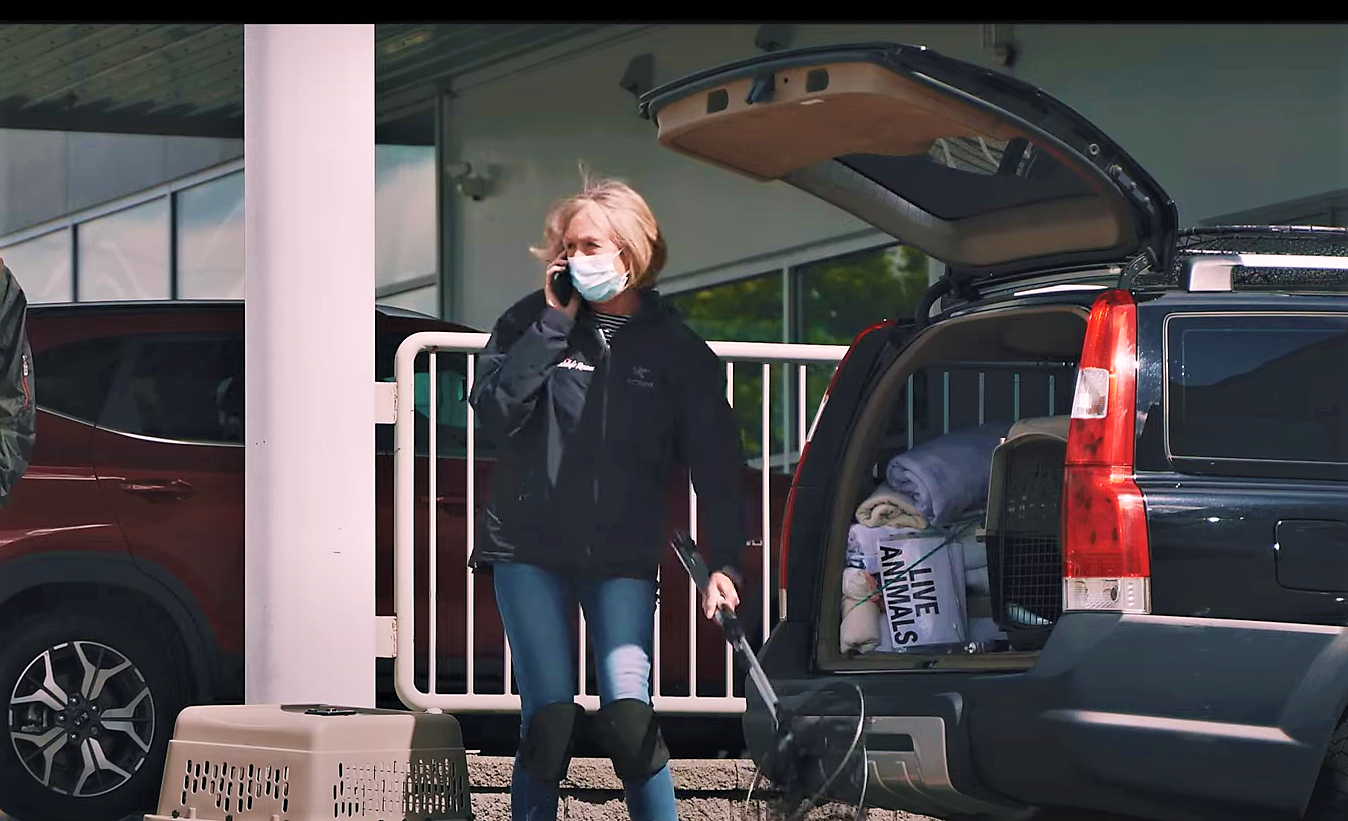
Rooftop rescues are usually done with a team of two or three, but there are cases when there just isn’t another team member available.
In this case there was a Canada goose family nesting on a balcony of a 4th floor condo at the east end of False Creek. The mom and goslings were on the patio, but the dad was on an upper ledge. For safety, and the least stress possible on the animals, I decided to catch the mom, get her in a kennel, then get the babies into the smaller kennel. The dad flew down to the ground, and by the time I got down with the mom and babies, he was waiting there, honking for his mate. As I carried the mom and goslings, he followed us across the street to the water’s edge where the family was released, all together again.
As soon as one rescue and release is complete, there is usually another to go to!
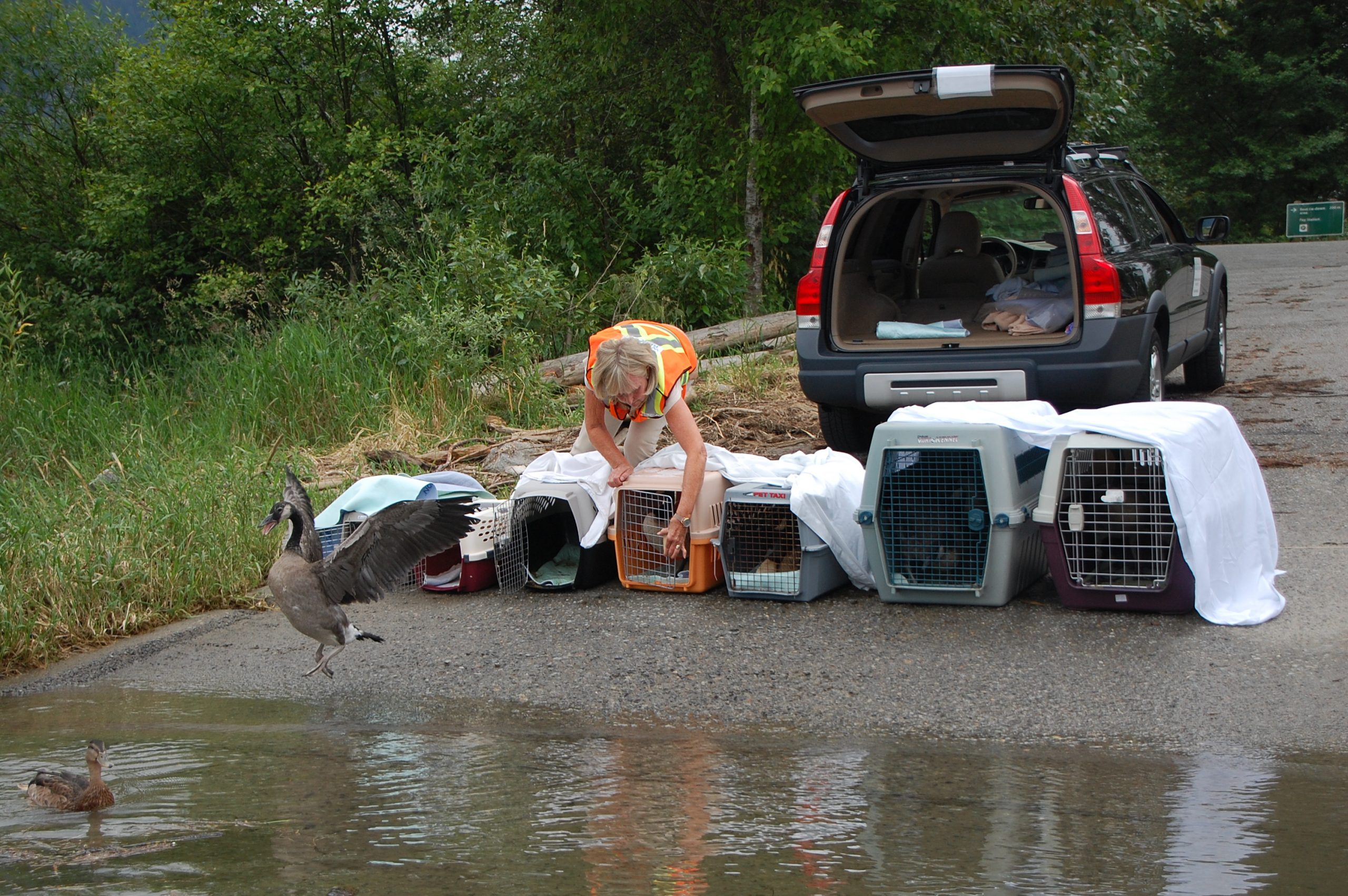
My next stop was to rescue a group of Mallard ducklings trapped on a ledge. The mom and some of the ducklings had made it to the ground and headed for the nearby pond. I quickly climbed up to access the ledge, scooped up the remaining babies, and took them to the pond to reunite with their family.
After that, I headed over to a downtown rooftop where a young Gull tangled up in garden netting. The parents were not happy with us being up there. We used an umbrella for protection from the dive-bombing parents and finally got the young gull free. We carefully removed all of the netting to prevent future entanglements.
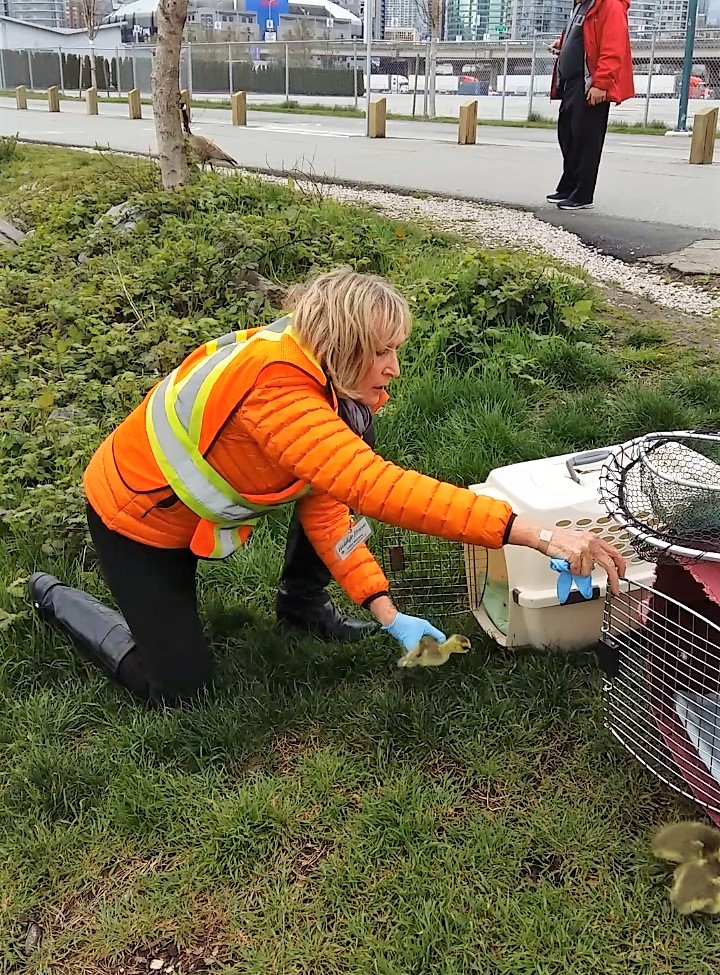
My last rescue of the day was another Mallard family rescue, this time trapped in an inner courtyard with no way to get out. Female mallards are notoriously flighty, so it can be challenging to capture her without her taking off and abandoning her babies. We use a domed tent-like structure to herd her into so we can net her, then scooped up the ducklings. With the entire family rescued, we were off to the nearest suitable water source, where they were successfully released.
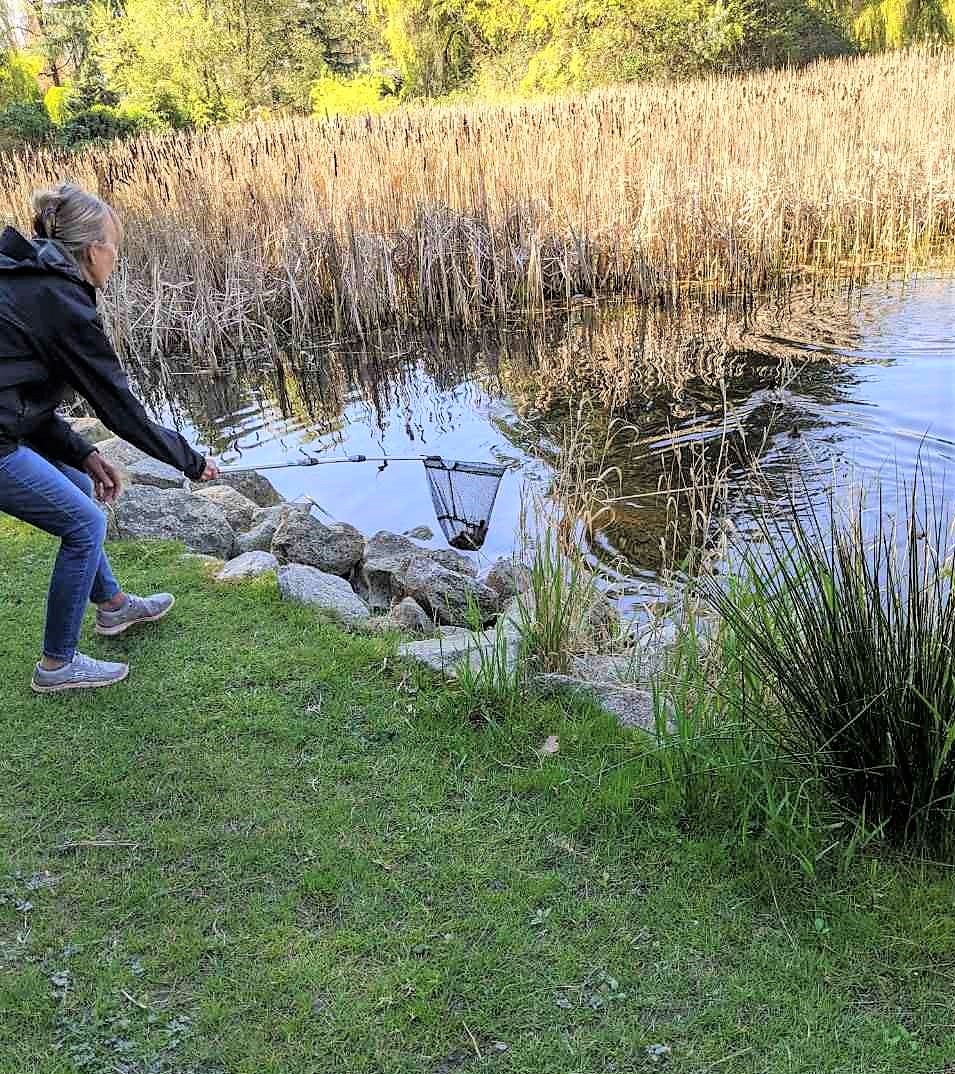
Throughout the busy Waterfowl Rescue season there are lots of calls about waterfowl in need of rescue. But, there are also always calls about orphaned skunks, raccoons, beavers, opossums and more! I try to fit these calls in between the roof top rescues and help as many animals as possible
At the end of the day, I clean out the kennels, replenish supplies, and get ready for another day of rescues!
Join the team! Learn more about volunteer opportunities and how to apply >
Volunteers are an integral part of Wildlife Rescue and they are involved in every aspect of the work that we do. We deeply appreciate each and every person that generously gives their time to help give our wildlife patients a second chance at life. Join us this week as we take a sneak peek into an average day for volunteers at Wildlife Rescue!
Written by Support Centre Volunteer, Nancy
As a Support Centre volunteer, we help out with admitting new animals and answering inquiries that come in to our Wildlife Rescue Support Centre. It is my first spring volunteering with Wildlife Rescue and we’re heading into the busiest time of the year, so the Support Centre Coordinator is close by to help me out if I have any questions. This day, we received lots of reports about baby birds and nests! This is a Day in the Life of a Support Centre volunteer!
12:20 – Arrived at WRA and greeted my fellow volunteer, Clare, who was admitting a new patient at our animal intake shed.

Clare at the intake shed
12:30 – Signed in and got an update from another volunteer, Brenda, who was finishing her helpline shift. She filled me in about a call she was expecting to come in a bit later from a community member so I could best support them. 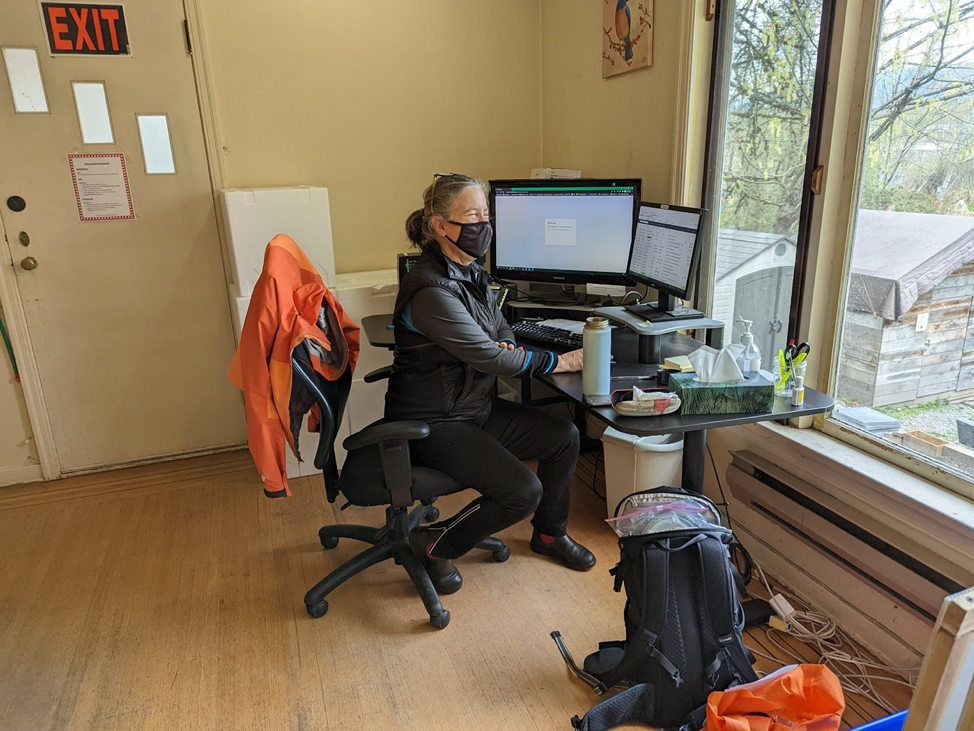
Brenda at her desk
12:45 – Wildlife Rescue received a about goose nests on a rooftop. I recorded information to schedule a rescue of these newborns once the eggs hatch.
Did you know: Canada Geese always return to the same place they were born to nest, even if a building or other development has popped up right on the spot! This keeps Wildlife Rescue busy year after year, safely rescuing and guiding newborns and their mums back to a safe, natural environment.
12:55 – I recorded all of the information from any voicemails that came through during other calls and responded accordingly.
13:10 – Wildlife Rescue received a call about an injured goose. I recorded the details and location for the Support Centre staff to arrange a rescue right away.
13:25 – An email came through about an injured Mallard with a video for assessment to determine the injury and if a rescue was needed.
13:30 – A call came through about an injured animal to be dropped off by a member of the community. I let Wildlife Rescue admissions staff know to expect them soon!
13:45 – I met an officer dropping off a Rock Pigeon from New West Animal Shelter to receive care at Wildlife Rescue.
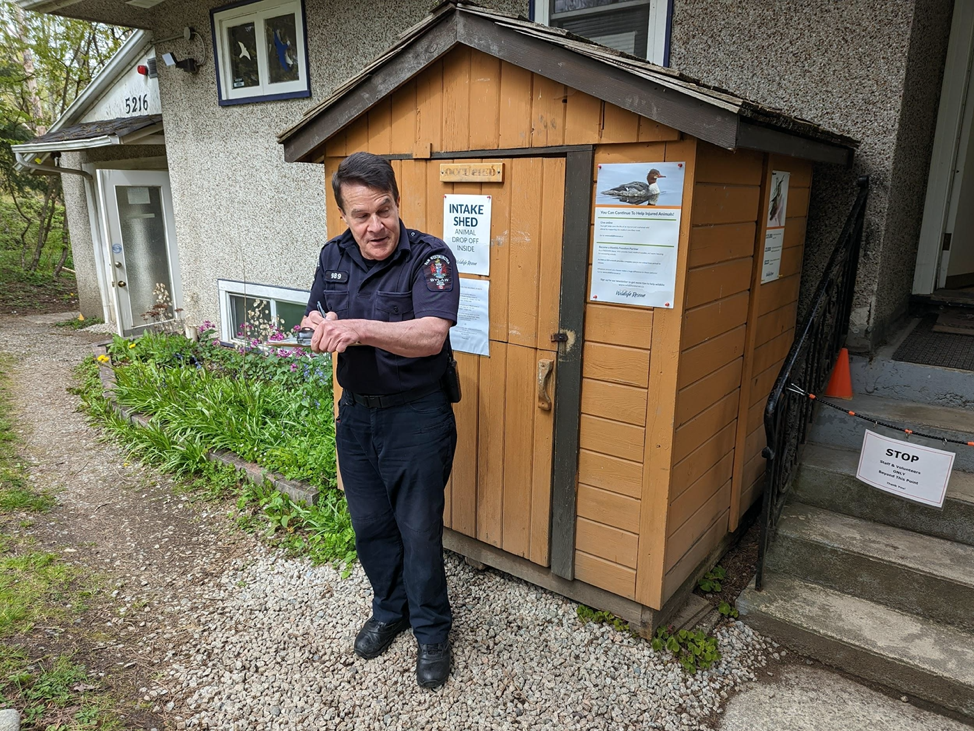
Officer Phil filling in a form with information about the Rock Pigeon he dropped off
14:00 – We received a call about geese behaviour and provided information to the caller to help them out.
14:10 – An available volunteer called and we arranged for them to assess the injured Mallard from earlier in person.
14:20 – We received a call about another rooftop goose nest rescue!
15:00 – We received a call from a concerned community member asking for advice on what to do with trapped ducklings with no mother around
Did you know: Ducklings rely on their mothers to survive—but if she becomes stressed, she might abandon her ducklings! If you see ducklings with no mother nearby, call the Wildlife Rescue Support Centre at (604) 526-7275 right away. Learn more about Mallard Duckling Season in our FAQ here.
15:10 – We received a call about birds nesting in an unsafe location, and provided guidance about nesting deterrents.
Did you know: if you see birds nesting in an unsafe place year after year, there are ways to safely try and divert them. Check out this article on goose nesting for more information.
15:30 – We received a call about an injured seagull who needed to be rescued and treated
15:40 – I sent out a request to Wildlife Rescue’s transport volunteers to arrange for the injured seagull to be picked up and brought right in for care!
16:00 – We received an update from our volunteers about the ducklings from earlier – the Mallard mother and ducklings were successfully reunited! What an amazing way to end the day!
16:10 – Signed out and our Support Centre team shared new photos of ducklings in our care swimming in a newly fixed up enclosure and reminds me why I’m so proud to be a part of the team helping these little ones at Wildlife Rescue!
Join the team! Learn more about volunteer opportunities and how to apply >
Volunteers are an integral part of Wildlife Rescue and they are involved in every aspect of the work that we do. We deeply appreciate each and every person that generously gives their time to help give our wildlife patients a second chance at life. Join us this week as we take a sneak peek into an average day for volunteers at Wildlife Rescue!
Written by Garden Volunteer, Teresa
I joined the Wildlife Rescue Association (WRA) back in March 2021 when I saw a volunteer opportunity I couldn’t resist: to assist in implementing the Wildlife and Demonstration Garden Plan at WRA.
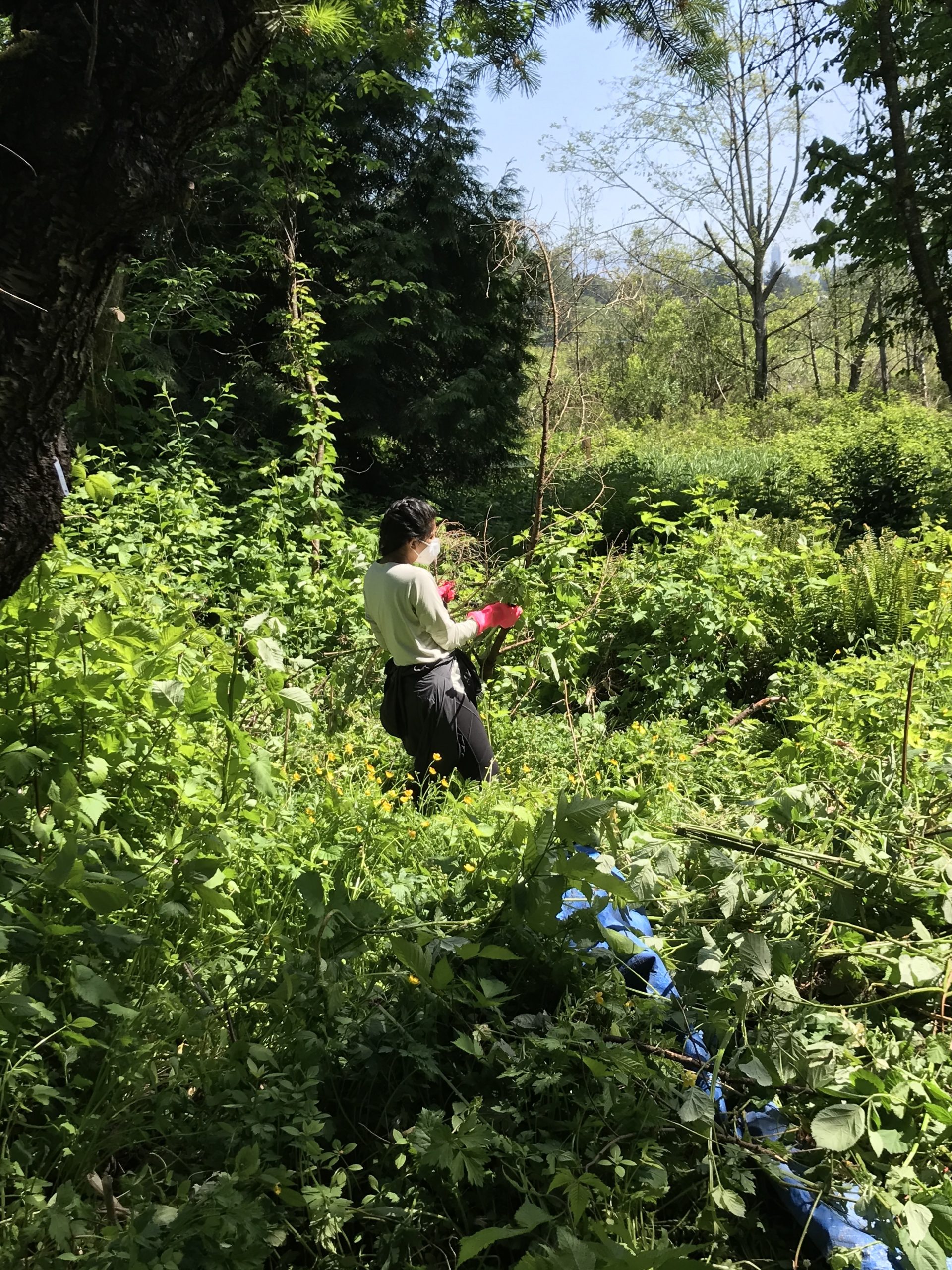
During my years as a landscape designer in Vancouver, I have found myself drawn more and more towards natural, ecologically sound landscape designs. The chance to assist in the creation of a wildlife garden, on such a beautiful site, was a dream.
The wildlife garden will provide shelter and food to birds, insects, and much-needed pollinators. It will also serve as a demonstration garden for visitors and a beautiful workspace for WRA volunteers and staff.
Right now, the focus of my work is to get rid of invasive species on-site and prepare the soil for the planting of native trees, shrubs, and perennials. A typical garden shift at WRA starts with a round of the site, to identify patches of Himalayan blackberries and morning glory to be uprooted, as well as maintenance tasks to complete.
Once the maintenance chores are done (mowing, weeding around enclosures, pruning), the serious job of weeding out of invasive species begins. This is physically demanding work, but at the end of the day, it is wonderfully satisfying to see the site free of weeds and ready to be planted.
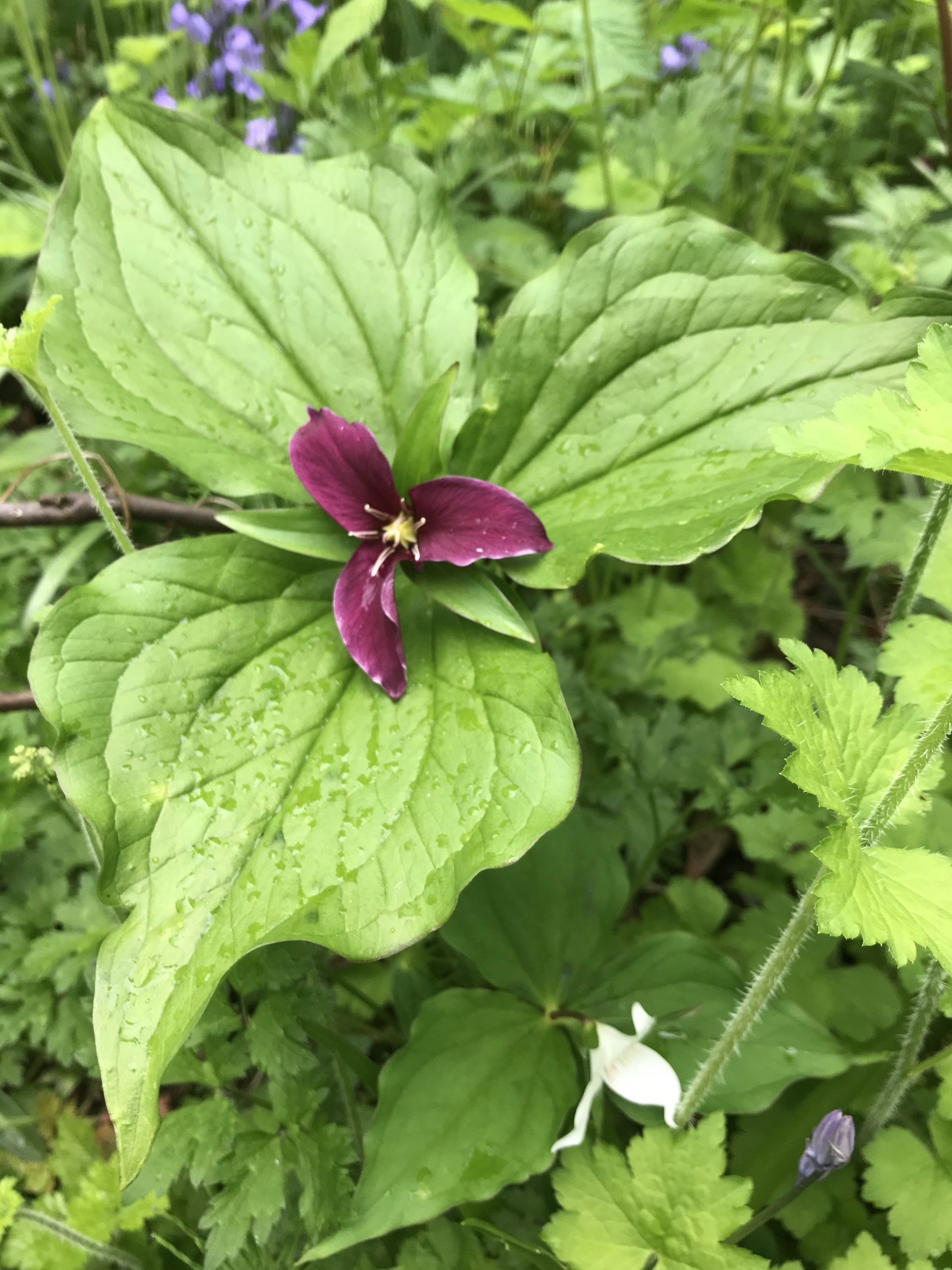
On my breaks, I sit by the lake watching the birds and ducks and feel lucky to be part of this wonderful project for positive change: providing much-needed shelter and food for local and migratory wildlife.
WRA’s site is full of surprises and delights – I have found hummingbird nests, delicate trilliums hiding amongst the weeds, and seen geese waddling by.
Garden work parties, where a larger group of volunteers and staff from across the organization come together to put in a few extra dedicated hours, are another highlight! I meet generous volunteers from all over the world, keen to help, hard-working, and ready to share their own unique knowledge of nature and wildlife.
Join the team! Learn more about volunteer opportunities and how to apply >
Volunteers are an integral part of Wildlife Rescue and they are involved in every aspect of the work that we do. We deeply appreciate each and every person that generously gives their time to help give our wildlife patients a second chance at life. Join us this week as we take a sneak peek into an average day for volunteers at Wildlife Rescue!
Written by Animal Care Volunteer, Isabel
2:50 pm – Arrived for my shift at the Wildlife Rescue hospital and was surprised with the best brownies and cupcakes in the break room—could the day start any better?
3:00 pm – I introduced myself to the new animal care volunteer I would be mentoring for the day, checked the board to see when the next patient feeding was coming up, and picked up a radio to keep in touch with the rest of the Wildlife Rescue team.
When one shift begins, another is just finishing up! Our first task of the day was to check in with the earlier shift and we helped them out with setting up greenery in a patient enclosure before they left for the day.
3:10 pm – We set up Aviary 14- a big enclosure with lots of greenery, milk crates, and roses nestled in the branches to give our feathered friends lots of fun places to perch and safe places to hide. Five volunteers on shift worked together and the job was done quickly! Wildlife enrichment is one of my favourite parts of volunteering at Wildlife Rescue because you get to be creative and wildlife live and play in your art! We create places to hide and perches at different heights to help them build their natural skills, keep their muscles strong, and be successful in the wild. It’s so special to give them a fun and safe environment that supports their needs whether they’re recovering from an injury or just learning how to fly!

3:30 pm – My mentee and I did some training and practice on common animal care shift tasks such as washing crates, preparing safe veterinary disinfectant solutions, and arranging clean and dirty laundry. We took a tour around Wildlife Rescue’s site to learn where the animal care tools and resources can be found and learned about animal safety and handling protocols.
One of the most important things we learn as animal care volunteers at Wildlife rescue is the important health indicators to look for in our wildlife patients and when to communicate concerns to staff. As we’re so often close by to feed patients or visiting their enclosure to clean up, volunteer observations can be key to their successful care!
4:30 pm – We visited the kitchen to check which patients needed to be fed at this time. By referencing the feeding schedule, our patient codes, and each patient’s respective diet in the manual, we were able to determine exactly which foods to pick up.
The schedule let us know we needed to check on some of the ducklings so next we visited 12baby ducklings in the brood sheds to see what food needed to be topped up and what needed cleaning. I demonstrated how to safely move the ducklings into a carrier while cleaning their enclosure and how to safely place them back while minimizing human contact and stress as much as possible. I cleaned both enclosures, carefully demonstrating the extra safety precautions we take at Wildlife Rescue such as diligently replacing gloves between each cleaning.

5 pm – We brought some dirty dishes to the sink, and garbage to the bin. Once we were washed up again, I supervised my mentee as we put together patient diets for more feedings. We carefully went through each enclosure and followed the protocol to open them safely and replace dishes with fresh food. Our new volunteer did a wonderful job and all patients were fed in no time! .
6 pm – We went back to the kitchen to complete some maintenance on our food preparation tools such as washing all the dishes from the day and sharpening knives.

7 pm – It was time for the last feed of the day and we fed the youngest of the ducklings we have in our care. Once again following Wildlife Rescue’s careful protocols, we removed the ducklings, cleaned their enclosure, and fed them their evening meals with as little stress as possible.
Afterwards, we visited the older ducklings as well and learned the differences in diet for each duckling stage and how to read the diet sheet to provide the right nutrition.
7:30 pm – We divided forces to wash the last dishes, sweep, and mop. We took out the garbage, recycling, and laundry and I filled out my mentoring report for this shift.

Finished for the day, we said goodbye to Wildlife Rescue and headed home!
Join the team! Learn more about volunteer opportunities and how to apply >
Supporters and friends,
Due to construction on the road leading to our facility, we are experiencing severe delays in traffic to our centre. We are working on establishing a new Admissions Centre for injured and orphaned animals that avoids construction delays. We hope to have this new site available in the next couple of weeks.
Until then, expected delays range from 15 minutes to 30 minutes, both in and out of Wildlife Rescue facilities. This delay will affect you if you are visiting to:
Wildlife Rescue is a non-profit organization, and our work is only made possible by your support. From your fundraising to your volunteering and your quick responses when you find an animal in need— we are so grateful for your continued support.
If you are planning to visit Wildlife Rescue, please contact our Support Centre for assistance before you arrive for the most up-to-date instructions and wait time estimates.
When a flagger asks to speak to you, always let them know you are going to Wildlife Rescue and if you do or do not have an animal with you.
If you are bringing in an injured animal, time is of the essence for the animal’s recovery, and we need your help to give them their best chance!
When you are stopped, please immediately make contact with the nearest flagger at the construction site en route to Wildlife Rescue and inform them that you have an injured animal in need of treatment. While we cannot guarantee you will be let through immediately, they will work to provide you with access to our facility as safely and quickly as possible.
If you are visiting to provide a donation or in-kind support, please call ahead or consider donating online at https://www.wildliferescue.ca/give/, through the mail to 5216 Glencarin Drive, Burnaby, BC, V5B 3C1, Canada or visiting our wish list for in-kind items.
At this time, we are actively seeking solutions to reduce these risky delays including establishing a satellite triage location, reliable transportation, and additional staff. Two sites are currently being assessed. More details to come over the next days as we secure these important resources.
With the patients rapidly on the rise, your continued support is needed now more than ever. Thank you for all you do!
Every day you learn something new as a Wildlife Rescue Dispatcher. The role involves answering many phone calls where you assist and educate the public on wildlife, arrange rescues and transports, and admit wildlife arriving at the hospital. There is never a dull moment during the summer at Wildlife Rescue! Even after four summers in this position, I continue to expand my knowledge of wildlife and encounter new, interesting situations every day! I have received a wide variety of calls concerning everything from fish to bears and many new bird species I had never heard of previously.
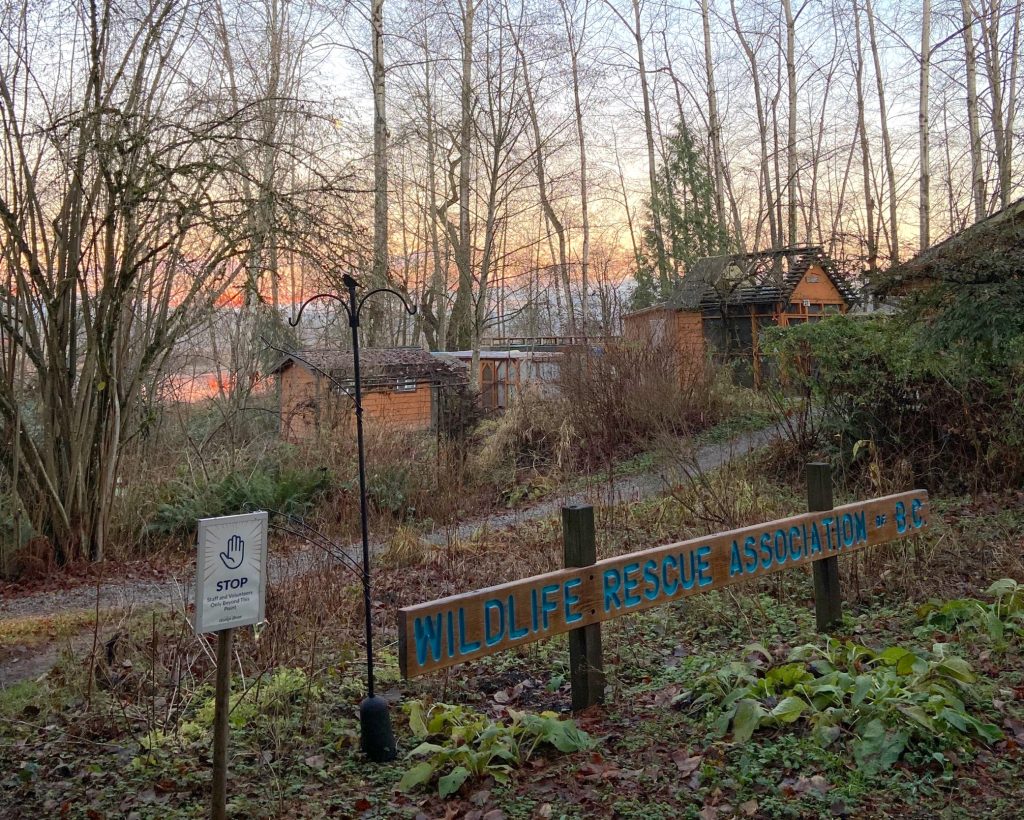
When I first started as a Wildlife Rescue Dispatcher CSJ in 2018, I was studying Geography and Environmental Science at the University of British Columbia. I began with minimal knowledge of birds and local wildlife, but the training and resources provided by Wildlife Rescue allowed me to quickly learn to assist callers. In this position, you are surrounded by knowledgeable staff and volunteers that are always willing to help and answer questions. It’s great to be surrounded by people who are passionate about wildlife and to have the opportunity to learn from them!
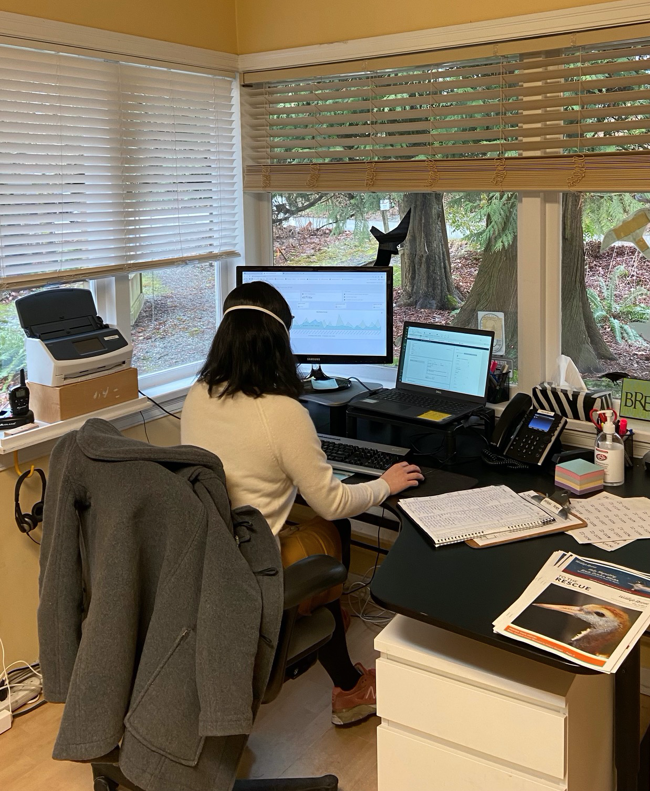
Helpline and Admissions volunteer answering calls and emails
As a Wildlife Rescue Dispatcher, it’s very rewarding to see the full picture of an animal’s rehabilitation. Starting from the phone call where someone finds an injured bird, helping them get the bird into the hospital, seeing the progress they make in care, to eventually seeing the bird leave Wildlife Rescue to be released back to the wild. Being a part of an animal’s rehabilitation and knowing you helped is an incredible feeling. It’s also very rewarding to help people in the stressful situation of finding injured or orphaned animals. People are very appreciative of the assistance we provide and it’s inspiring to see people going out of their way to help wildlife.
If you enjoy working in a fast-paced environment, continuously learning, and are interested in wildlife, Wildlife Rescue Dispatcher may be a great position for you! You will gain valuable skills such as time management, problem-solving, leadership, and public education all while helping wildlife.
Aiden Stephens
Wildlife Rescue Dispatcher 2018-2021
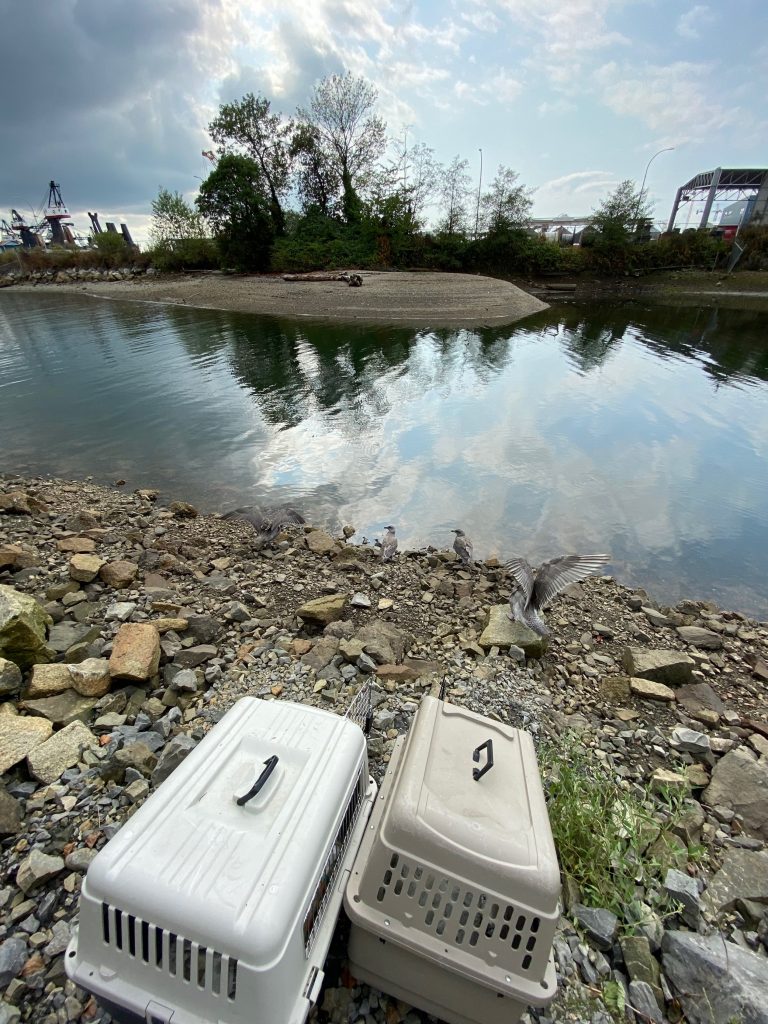
Releasing some young Glaucous-winged Gulls
Although the overall flow of everyday as a Wildlife Care Assistant at Wildlife Rescue is similar, no two days are ever exactly the same or anything even close to boring. Going in you know you will be getting to feed baby birds, clean out their enclosures, perform their daily health checks, and that you will most likely be going home with poop somewhere on your clothes. No day is ever dull because there are always new species coming in to learn about, new medical issues arising, and new problems popping up that need to be solved in ever-changing ways.

Two newly admitted orphaned Anna’s Hummingbirds in their nest
In this role, you get to work with all kinds of altricial baby birds from species as tiny as a hummingbird or chickadee nestlings (that demand to be hand-fed every 15 minutes), to some of the bigger corvid species like Northwestern Crows or Steller’s Jays. The feeling of getting to raise an orphaned bird from being completely dependent on you to be fed and cleaned all the way until it is independent and ready to be released back into the wild is incomparable.

A Black-Capped Chickadee fledgling being syringe fed
I was a Wildlife Care Assistant, Canada Summer Jobs (CSJ), in the baby bird room for the spring and summer of 2021. Before this, I had received a Bachelor of Science in Biology from the University of Calgary and worked at wildlife rehabilitation centers in Alberta, Nova Scotia, and Costa Rica, but this wasn’t the case for most of the CSJ’s. Many people who take on this role are current students who have never worked with animals a day in their lives and are looking to gain some hands-on experience before graduation.
Whether you have a long list of experience working with baby birds, or you don’t know a thing about the wildlife rehabilitation process, this is an extremely rewarding position with tons to learn. Everyone at WRA, from the staff to our amazing volunteers, is more than happy to help you learn and lend a hand. The entire property is filled with a team of people who just want to do anything they can to help out wildlife and it makes for a very welcoming and passionate place to work.

A fledgling Varied Thrush (mid moult) getting their daily health check
Every day I went to work was a crash course in bird handling, feeding babies, learning the identification and natural history of species, and so much more. In the beginning, it can be very overwhelming as there are many skills that need to be picked up quickly and every day is a bit of a juggling act to make sure all the patients get everything they need, but once you get into a groove, the days fly by and are extremely rewarding (even with all the cleaning and the poop). Every single day I went in I learned something that made me fall even more in love with birds and I got to go home knowing I got to make a difference in at least one bird’s life, and for me, there is not much more I could ask for.
Raelee Barth
Wildlife Care Assistant 2021
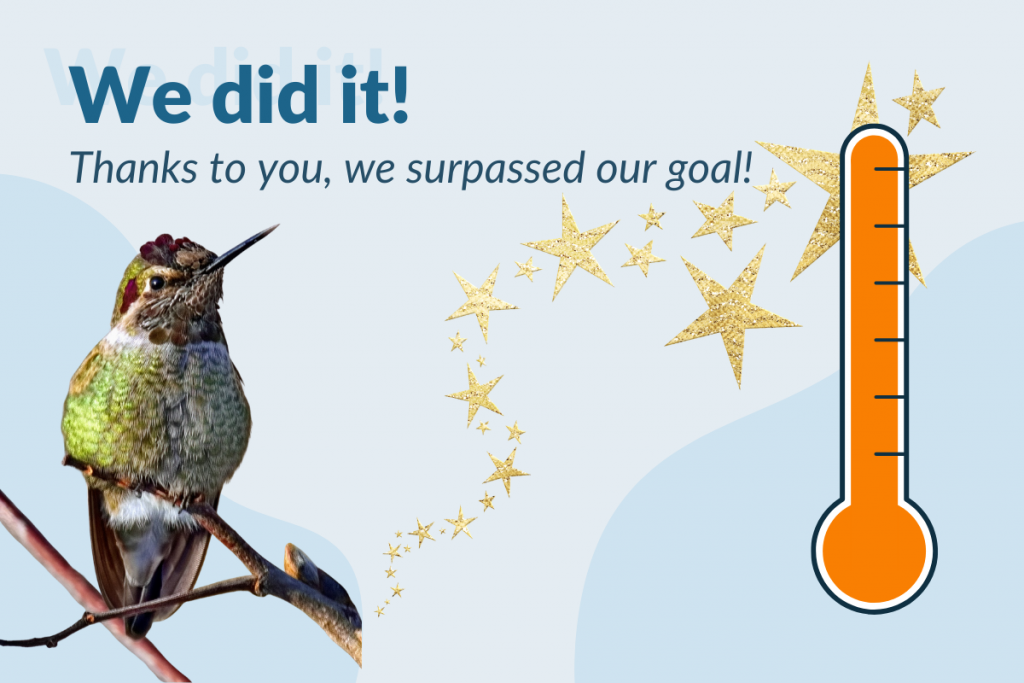
From December 27-31st, Wildlife Rescue ran a gift-matching campaign with the goal of doubling $60,000 in matching funds to a total of $120,000. Thanks to your amazing community support, we reached this initial target within the first two days which inspired new match donors to come forward with additional challenge gifts, increasing our goal!
Thanks to your generosity, we reached $233,286.01, blowing our original goal of $120,000 out of the water!
This could not have been better timing. During the unprecedented weather we experienced over the last few weeks, we took in a record number of Anna’s Hummingbirds and Red-breasted Sapsuckers with frostbite, dehydration, and damage from getting stuck to frozen metal feeders and other objects!
Thank you for your continued support! We could not do this life-saving work without you!
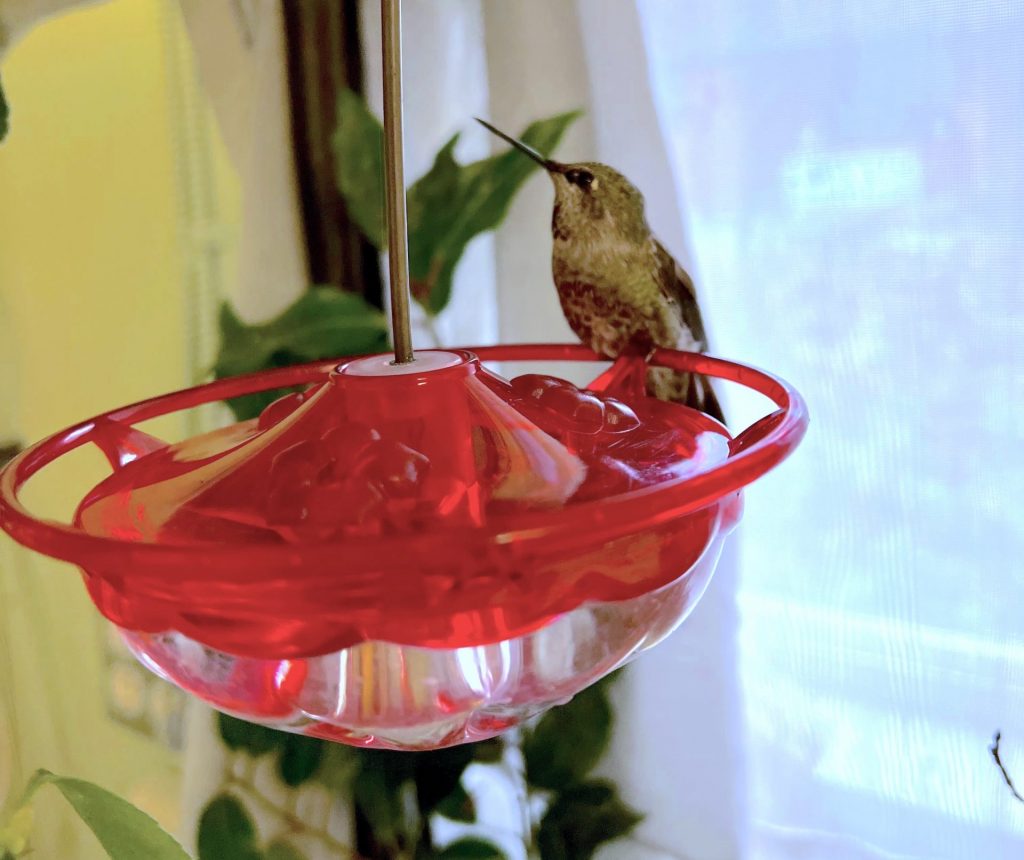
Anna’s Hummingbird in care at Wildlife Rescue
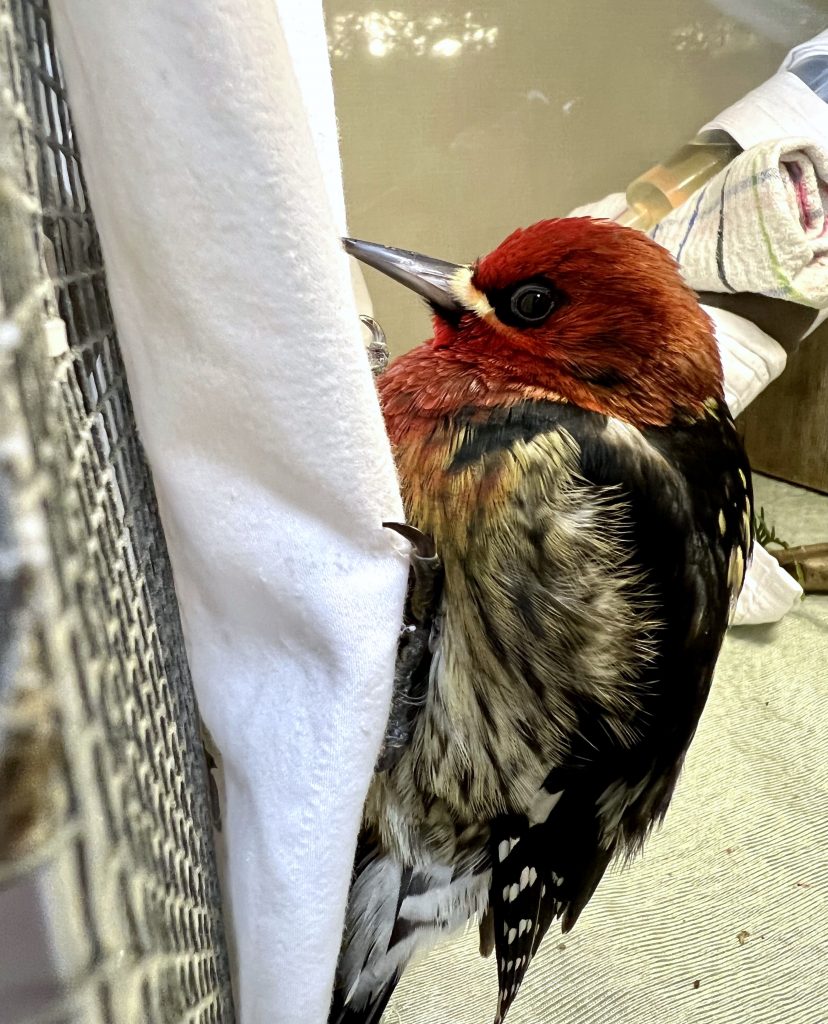
Red-breasted Sapsucker in care at Wildlife Rescue